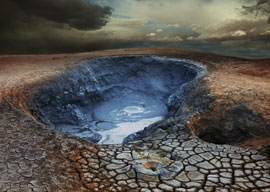
December 26, 2013

Antelope Canyon
Source: Shutterstock
In a recent edition of Radio Derb I mentioned the advantages of moving to Iceland but added: “The downside is, you have to not mind living on a volcano.”
One listener”there’s always one”saw my volcano and raised me a supervolcano, attaching this news clip:
A new study by the University of Utah revealed that the hot molten rock beneath Yellowstone National Park is 2½ times larger than previously estimated, meaning the park’s supervolcano has the potential to erupt with a force about 2,000 times the size of Mount St. Helens.
This hasn’t actually happened since 637,987 BC, but the boffins reckon another eruption is overdue. When that sucker goes “pop,” you can kiss goodbye to the USA. Our land, our parks and monuments and Civil War battlefields, the fruited plain and the alabaster cities, our Constitution, all three branches of the federal government, you and me and our sweethearts and kids and pets and parasites (some overlaps there), will all be buried under ten feet of ash. The rest of the world won’t fare so well, either, with agriculture killed off for a decade or two.
These prognostications of doom generate surprisingly strong emotions. Persons with no faith in an afterlife dwell fondly on them, perhaps feeling that their own personal extinctions don’t seem so bad if humanity at large, or most of it, will be swept away in one big whoosh at approximately the same date. Believers, on the other hand, greet such prophecies with anger or ridicule, confident that YHWH, Allah, Odin, Vishnu, Unkulunkulu, the Great Manitou, or the White Goddess would never allow such a calamity to befall the Chosen Species.
Considering the things that s/he has allowed, I call this cockeyed optimism, but the difference of opinion here is probably just temperamental.
Doom-relishers are no fringe minority. There has hardly been a significant society without some vision of the End Times in its mythology, often lovingly described. Destruction myths have been as common as creation myths, although they generally come with appendices promising a new, better cosmos to the survivors.
(The main exception here is China, whose thinkers have produced neither creation nor destruction myths above the folk-superstition level. “This wholly undynamic conception of time which lacked any and all orientation, even toward the past, excluded the concept of a beginning as naturally as it did one of the end of the world.” “Prof. Bauer.)
So we’ve been contemplating the End Times since, I guess, the Beginning Times.
Well, if you like that kind of thing, I have a doozy for you. I’ve just been reading James Barrat’s book Our Final Invention: Artificial Intelligence and the End of the Human Era. We may, says Barrat, be living in the twilight of humanity, the Menschheitsdämmerung. (There’s a book of German expressionist poetry with this title, for which dämmerung is usually translated as “dawn.” The more usual meaning is “twilight,” though.) What happens to Wotan and his pals in Act 3 of Wagner’s opera is about to happen to us.